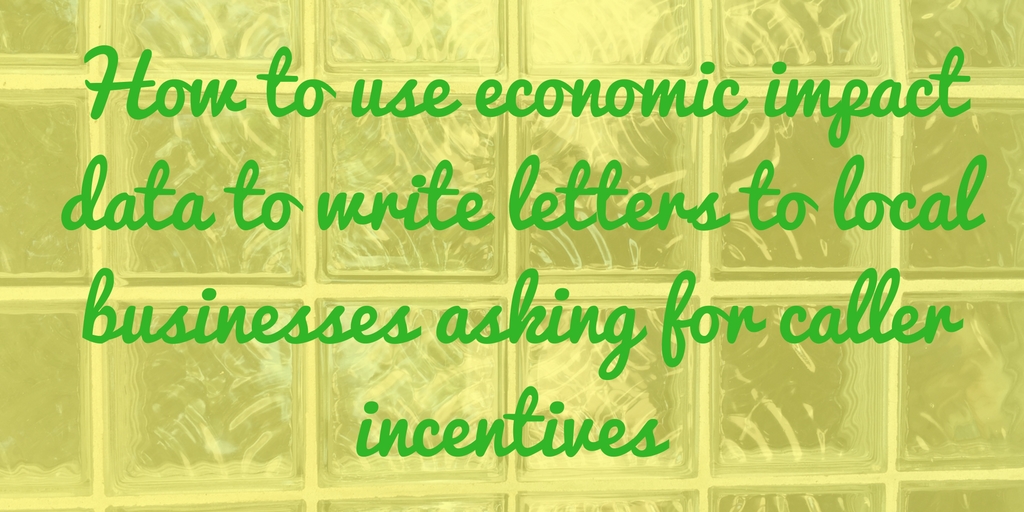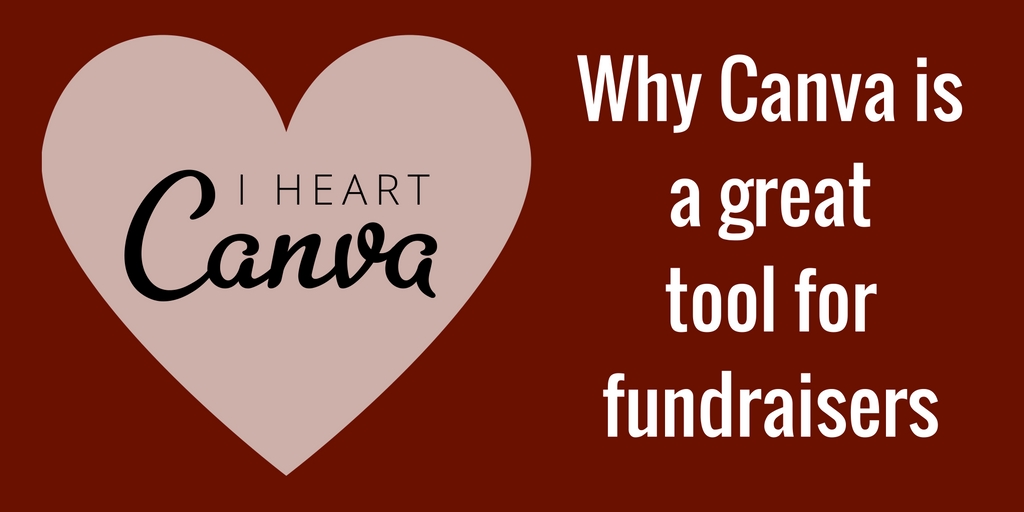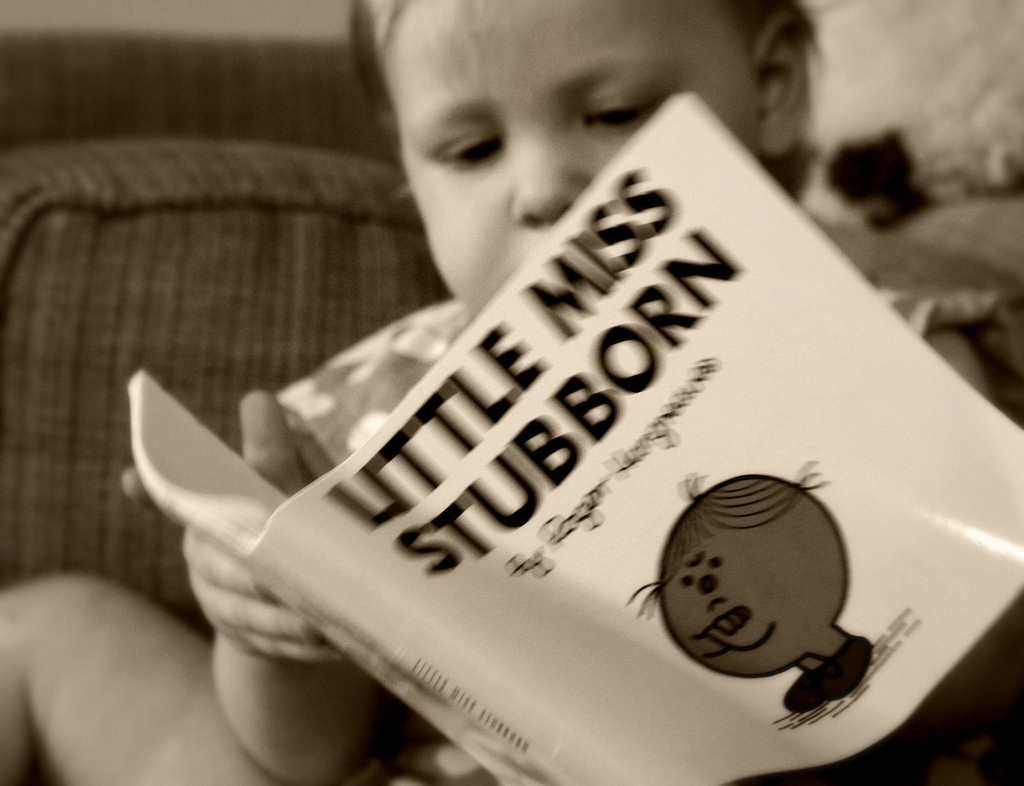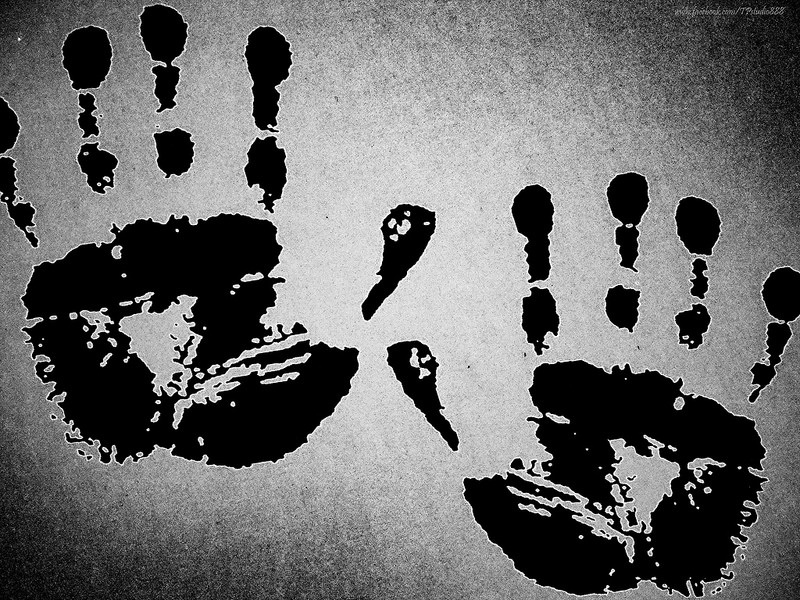|
One of my most favorite techniques for improving caller motivation is to write letters to local businesses to ask for “gifts-in-kind” to use as prizes for outstanding callers. That idea is far from new, but there is one tweak that I think many haven’t thought of that makes all the difference in terms of success.
Many universities and colleges commission economic impact studies that quantify the value that these higher educational institutions have on their local economies. These studies usually herald impressive numbers, from the number of jobs provided by the university to the total estimated dollars of economic impact. Here are a few examples to show you what you’re looking for:
If you can get your hands on a study like this specific to your institution, you will be able to craft a letter that is optimally successful. Some studies have a statistic that actually shows how much money university students spend in the local marketplace, like the ones from Notre Dame and South Carolina above. If you can get this figure, it’s clutch. The data from these sorts of studies will motivate the businessperson to get their business more in front of students. They will see what a significant portion of their business that students (and the university in general) represents. And you will be providing them with a quick and easy way to advertise to students. All they need to do is provided a few coupons for free merchandise or services and you will not only put them on your webpage or Facebook (or both) but you’ll give these out only to the top performers so they get to try their products. To find an economic impact study for your institution, start just by googling “economic impact study” and your institution’s name. If nothing comes up, contact the College of Business or Economic Development department at your institution and they may know of a study or where to find it. Some universities do a great job of promoting this important information and others don't exactly. It may be hidden away in some office of institutional research. Put it to good use. Do you solicit “gifts-in-kind” from local business for your phonathon? If you have a killer letter that you use, please share the text in the comments! I made a post some time recently about using Etsy to reduce graphic design costs. It's a great option for some shops but after writing that post, a friend and colleague pointed me to Canva.com. It is by-far the best tools for amateurs to produce quality graphic design that I've seen. In just a few weeks, it has become indispensable to me, both personally and professionally.
For example, we are using Canva at the school I currently work for to produce graphics for a social media campaign around a challenge grant. We update the numbers regularly. This would be something we might have to pay a graphic designers for each image but we do all of this in-house now. Not only are we saving money but we can produce top-quality images fast and have the ability to produce more in quantity and variety than ever before. (And Canva isn't just for digital images. You can download print-quality images and send those to the print shop.) I also use Canva to produce images for my blog and the cover of my e-book. It's been fun learning this tool and everything it can do. Best of all, Canva is largely free to use. There are some valuable features available via their paid product: Canva for Work. If you want to share images and work on them with colleagues or save your brand fonts and colors, Canva for Work is only $19 or so per month. Canva makes money by selling the images on their site for $1 each. I've used a few but not many. I find it equally easy to snap pictures of things that would make interesting backgrounds on my phone and then use those. I don't make any money in recommending Canva. I just felt that as a follow-up to my previous article, I should alert my readership to this amazing resource that makes our work so much easier. PS - Canva has a great app that makes it seamless to move images on and off your phone. So, if you use instagram quite a bit for fundraising, this a big advantage. How are your public speaking skills? It’s an important skill in any business but in fundraising, it’s essential. Fundraising is about communicating vision through relationships. Sometimes this relationship building happens one-on-one or in small groups. But, more often than not, you are in situations which require you to speak in front of a medium to large group. This can manifest as donor recognition event, fundraising events, board meetings, volunteer training sessions and conference presentations.
If your job doesn’t require much in the way of public speaking from you, find a place to practice. Write a presentation for your local Association of Fundraising Professionals chapter. Send in a proposal to present at the next Council for the Advancement and Support of Education district conference. Join your local Toastmasters group. The more you practice, the better you will get. Practicing your skills as a public speaker will pay dividends for your career and for your organization. Everyone has their own process for preparing and practicing. For me, I begin with an extended outline. I put it all into Powerpoint, trying to use more images than words. I keep the wordy outline as notes for me. I like to extemporize during a presentation somewhat. I’ve never been one for reading from a text. So, closer to the actual event, I shut my office door and run through the entire presentation standing up at full vocal power. (In dance, they call this doing it “full-out”.) I fully visualize my audience and anticipate questions that they may have. I also try to insert as much humor as possible. The other practical tip I have in this area is to focus on your posture. The impact of excellent posture on public speaking cannot be overstated. Your posture is the root of both your voice and your confidence, both essential to getting your message across. It’s not just about standing up straight. It’s about relaxing in the right areas and the position of the chin. Good posture is about opening the chest to vulnerability while standing on a firm foundation. The biggest personal benefit you will get from more public speaking experiences is more confidence. No matter whether I nailed it or bombed, every speaking gig I’ve ever done has ultimately built my confidence. If you mess up, you learn more about what not to do. If you nail it, well, you confirm your awesomeness. I work from home and it is difficult to get enough movement when you walk basically to the kitchen, your office and then to your bedroom every day. I had gotten lax in my exercise regimen (what there was of it) and was waking up feeling stiff and sore every morning.
So, for these reasons, I decided to challenge myself. I wanted to do two things every day: at least 20 minutes of yoga and get 10,000 steps. I add a daily entry indicating that I have done it on my Facebook profile with a status update and the hashtags: #yogaeverydamnday and #10Ksteps. Probably it annoys more than 3/4 of my Facebook friends, but I don't care. In my opinion, I'm helping them with their own practice of scrolling past things that annoy you. By Day 10, something weirdly amazing started to happen. I had had a terrible day. My kids had gone bonkers. It was a weird, off day and I basically ate my weight in Mexican food to cope. It was 9PM, my children were finally asleep and I only had like 3,000 steps. What did I do? I stayed up until midnight and got those damn steps, that's what I did! I could have just stopped posting about it on Facebook and no one would have noticed or cared. But, at this point, I was invested. I didn't want to stop for one bad day and have to "start over" with another 30 days. Intractable stubbornness had set in. That stubbornness made me do it because I wanted to, just because. Even though it was hard. Even though there were no gold stars and no one would have cared if I stopped. Now, I'm on Day 15 and I'm starting to see more and more benefits, but the biggest is just the satisfaction that I didn't freaking quit. Why am I posting about stubbornness on a blog post that's FUNdraising Friday? For a few reasons:
All that said, where in your work can you activate the power of intractable stubbornness? What areas of your personal life could benefit from the same mindset?  Goal: a personal or organizational desired end Projection: a calculation of some future thing These two terms are related but subtly different. Generally speaking, for a healthy organization, the projections drive the goal setting process. However, at some organizations, the goal is a different (and perhaps totally unrelated) number to what you project that you can actually raise. At some institutions, an unreasonable, unrealistic goal situation may arise from a team leader that doesn't understand the difference between a goal and a projection and they pick an arbitrary figure that sounds good. ("Let's raise 10% more this year than last year", for example.) Or, it may have come about because of real budgetary needs of the institution for unrestricted support. Creating projections is a tedious process requiring a patient analysis of past performance and building models for future performance. So, if you have a firm goal set before you that you know (or believe) you cannot reach, why should you bother to create elaborate projections? Here are three important reasons to do projections even if your goal is already set: 1) Projections will help you to pinpoint the shortfall Setting projections shows you where the program is not performing to expectations and why the goal is not feasible (assuming that's true). It helps you to tell the story to those in management of what is really happening with the fundraising. 2) The process may help you to identify potential areas of opportunity Projections can show you opportunities that you might have overlooked. You build your projections segment by segment and it is possible that you might have some new segments that you haven't solicited before or that you have a new strategy for. These may help you get closer to your goal. 3) You need the projections to become a lobbyist for your program. It's illogical to do the same thing every year and expect different results. With a projections spreadsheet, you can show what's possible with more budgetary resources. You can tell the story that with [this much] future investment in the program, [this much] more revenue can result.  Now is the time to be thinking about how you are going to train your new callers. But, the truth is you aren’t just training phonathon callers. You are training young fundraisers. If you do it right, every caller in your center will have a knowledge of fundraising that rivals most experienced development officers. The techniques that your young fundraisers learn can be applied in nearly any area of business that they choose to pursue. If your system reinforces these lessons, they will be incredible young fundraisers. They will raise serious money for your institution and have an impact on many students, faculty, and staff. From the time he or she is hired, you are a part of that student fundraiser’s education. He or she will also be an integral part of the life of your educational community. A Holisitic Approach to Training If staffing is about quantity, training is about quality. Of course, you want staffing to be about quality too but speed takes precedence. In training, you should still be as efficient as possible but that isn’t as important as being effective. You want to take all of these students you hired and make them into incredible young fundraisers. When someone says phonathon training, generally “new hire training” is the first association we make, as if that’s the only kind of training there is in a call center. Training is necessary throughout the entire time that a caller works with your phonathon. If we take a more holistic approach like this, quality and quantity begin to work together. Believe it or not, you can get more done in less time and it works to the benefit of both the callers and the program. Here’s my proposal: what if we presume that for the first couple of weeks new callers will be calling only future donors (my optimistic phrase for a non-donor)? Suddenly, there a ton of things we just wouldn’t need to cover in new hire training. Upgrades, special giving societies, leadership levels, extra objection responses and fresh ways to build rapport could wait a couple of weeks or a month. Now this change of perspective on new hire training as outlined above does three amazing things:
Training doesn’t only happen on the front end. Training actually starts in the interview process, as that shapes how the employee views the expectations and responsibilities. And training continues every single night in team meetings, coaching, and formal continuing education sessions. Training continues as new hires become donor callers, donor callers become new hire mentors, and lead callers become student supervisors. Once you switch your perspective, you don’t feel the pressure to squeeze everything in during new hire training. You can then consciously design a holistic growth and education program that will teach each student fundraiser what they need to know when they are ready to learn it. Oh, by the way, this kind of "life-cycle" training that I recommend will have the end result that you “grow your own” call center leaders. If you put these strategies into play, you will have many productive callers, but also many mentors and leaders in your call center. When you get promoted, and you will, you will have graduating seniors ready for a chance to make their mark on your institution. Talk about succession planning! Giving donors reasons to give is an important part of case-building. Don’t underestimate the simple power of a top ten list. Here is a list of ten possible reasons to give to get you started brain-storming your own reasons to give at your institution.
You can create a dedicated webpage out of these and then promote one per week or day on social media and then repeatedly re-post the website. Make sure your text explaining each of these reasons has links to your giving page. #10: Tuition is not enough. Tuition usually only covers a portion of the cost of an education. See if you can use this reason to give to present this data. Emotional appeals are great for many donors but others want to see the numbers and facts. #9: Open doors of opportunity. Community support is critical to helping hard-working students graduate. Many of your students could not afford an education without scholarship assistance. Make that case with this reason to give. #8: Invest in today’s students, tomorrow’s leaders. A gift to your institution helps to clear a path to a degree for many students. Perhaps quickly mention a story of what one of your recent graduates is doing that is impressive and noteworthy. #7: Gifts help your institution attract major gifts and grants. Foundations and corporations often consider charitable support to be an indication of merit. For example, they may look at the percent of alumni giving, the percent of employee giving and the total dollars raised each year when evaluating a grant application. A gift sends a signal to these outside funders that your institution is worthy of their support. #6: Maintain the value of a degree from your institution. Giving, as we know, is key factor considered by accrediting agencies and ranking institutions like U.S. News and World Report. It’s important to communicate to our constituents that especially if you are a graduate, your gift will help the institution maintain accreditation and increase its reputation, thereby increasing the value of a degree from your institution. Even a small gift makes a difference. #5: It doesn’t take much! Your gift, combined with the gifts of others, can have a very powerful impact, regardless of the amount. No gift is too small to make a difference! Together we can reach our goals but we need your participation. #4: It’s a worthy tradition. Your institution has been educating people since its year of founding and it is likely that your institution has been sustained by generous gifts at every step along the way. It is vital that today your alumni and friends carry on this important tradition of generosity. #3: Amplify your values. When you give to your institution, you are giving to students who are also future leaders. What do you students do when they leave your institution that is unique and valuable? Whose lives will your students change? #2: The world needs your institution. For this reason to give you will really needs to dig into what makes your institution unique among other institutions. What do you offer the world that no one else can? #1: Now is the time… Make an investment in your institution so that it can expand its mission. Explain why your institution is unique and precious and that the time is now to make a gift which will be tangible evidence of the hope we all share for how this institution can change the world.  The concept of "grateful patient" fundraising has always fascinated me. How meaningful, how wonderful, how . . . . EASY to raise money from those who lives were saved by your institution! A team of specialists at your hospital saved someone's child from cancer and they have capacity. What a wonderful story! Of course, I know that it isn't that simple to raise money in healthcare fundraising. But, the stories of grateful patients are enticing and make those of us in higher education a bit jealous. Unfortunately, most stories are a bit less tangible than that in higher education. No matter what kind of organization you work for, I find it is a great exercise to reflect regularly on the question, "Who are your grateful patients?" Asking this questions drives you right to the core of your mission. Who is served by your institution? How does it change lives? These questions takes you deep into impact and narrative. This question leads you to the "Why?" In higher education, who are our grateful patients? Last week, I was composing a blog post about how philanthropic support has directly helped me in my life and career. We often think of students as our grateful patients and they are. But, more than that, it is our ALUMNI that are the grateful patients. Students who graduate and move out into the world changed by the education they acquired at our institutions. The stories of students work to connect our alumni to mission only if those stories activate the sense of gratitude that our alumni have for their own time at our colleges and universities. It's not mere nostalgia, it is a real and tangible linking back that our student narratives must do in order to invigorate the "grateful patient" sensibility of our alumni. They must see in the story of current students their own story and from there be able to project what their life might be like if their educational story was different. The phrase "make a difference" is overused and trite. However, if you want to find your grateful patients (who will be not only your best donors but your most enthusiastic advocates), you have dive into the real meaning of that phrase. How is someone's life path qualitatively different because your institution exists? I'm a HUGE Michael Phelps fan. When I did my recent post about "Be Like Mikhail!" it could very easily have been about "Be Like Michael!" instead. He is a similar inspiration in terms of excellence.
If you haven't been following the Olympics, one of Michael Phelps' opponents was trying to annoy him and psych him out before a race and his response was a facial expression to rival Grumpy Cat! Who knows whether he was just in the zone, truly annoyed or just doing isometric warm-ups, but it set the internet on fire for a while. An informal caption contest was raging with the hastag #Phelpsface. Anyway, I was a bit inspired and create a number of non-profit and fundraiser things that make me go #Phelpsface. Here's the collection for your Friday laugh: When you're an annual fund person interviewing for a #majorgift position and they like you but think you don't know how to #ask. #phelpsface When people ask you if plan on working in #phonathon forever. As if you have a #calling for it. #PhelpsFace #telefund #punny When you hear "all we need to worry about is #donorretention. This year we're cutting the budget for acquisition." #PhelpsFace #fundraising When someone uses 5 different fonts and 3 different styles of bullets in one document. #Phelpsface #graphicstandards #pleasenocomicsans When it's 20 mins after the meeting start time and the Skype call hasn't started. #PhelpsFace #nonprofit #fundraising When somebody suggest not calling #youngalumni because "they have too much #studentloan debt. #PhelpsFace #phonathon http://bit.ly/2aKm9NZ When a manager doesn't require 3 asks for callers, they trust them to do their job. #PhelpsFace #telefund #phonathon http://bit.ly/2bpP2U5 When leadership says they need annual giving to cut the budget 10% but bring in 20% more funds. #PhelpsFace #annualgiving #fundraising When it's 4 weeks into calling, your manager shows up and the seats are half empty. #PhelpsFace #phonathon #telefund http://bit.ly/2bovCuE When administrators want to shut down #phonathon calling because of three complaints. #PhelpsFace #fundraising #telefund When people say, "all fundraising will be done with QR codes in the future." #PhelpsFace #fundraising When you tell someone you work at the #phonathon and the reply is, "so you're a telemarketer." #PhelpsFace #fundraising When you're at a conference and someone says, "Direct mail is dead you know." #PhelpsFace #fundraising When you send an email about a thing you need today and get and "out-of-office" reply. They'll be back in two weeks. #PhelpsFace #nonprofit When you sent save-the-dates and invites (email and mail) and a board member says, "oh, I didn't know about it." #PhelpsFace #nonprofit I’ve talked about finding the stories of impact and sharing them with your donors. The importance of letting donors see how their gifts have transformed lives cannot be overstated.
Upon reflection, I realized that I have overlooked throughout my entire career, one very important story: my own. I have searched for the stories of scholarship recipients at every institution I’ve worked for and totally forgot to be recognize the impact donors have had on my own journey. I was lucky enough to have been awarded a 4-year leadership scholarship which covered my room and board at my alma mater, The University of Southern Mississippi, but I was also the recipient of a generous scholarship so that I could go to London one summer for study abroad. The Dean of the Honors College also sent me on two trips (one to Princeton and one to Washington, D.C.) using funds that I now know must have been generated from Annual Fund gifts. I also know that charitable donations helped to support the fantastic Honors Forum series that brought the most incredible scholars and public intellectuals to Hattiesburg, Mississippi. Here are some experiences that I have been able to have because I received scholarship support:
With sincere thanks, Jessica Cloud |
Jessica Cloud, CFREI've been called the Tasmanian Devil of fundraising and I'm here to talk shop with you. Archives
June 2024
Categories
All
|








 RSS Feed
RSS Feed
